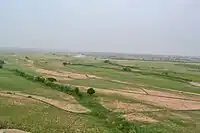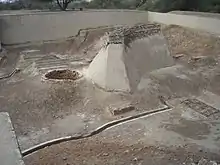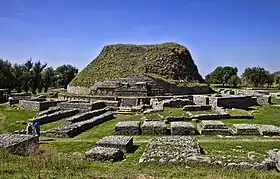Pakistan is home to many archaeological sites dating from Lower Paleolithic period to Mughal empire. The earliest known archaeological findings belong to the Soanian culture from the Soan Valley, near modern-day Islamabad. Soan Valley culture is considered as the best known Palaeolithic culture of Central Asia.[1] Mehrgarh in Balochistan is one of the most important Neolithic sites dating from 7000 BCE to 2000 BCE. The Mehrgarh culture was amongst the first culture in the world to establish agriculture and livestock and live in villages.[2] Mehrgarh civilization lasted for 5000 years till 2000 BCE after which people migrated to other areas, possibly Harappa and Mohenjo-daro.[2] Harappa and Mohenjo-daro are the best known sites from the Indus Valley civilization (c 2500 - 1900 BCE).[3]

Stone Age
Lower Paleolithic (Pre-Soanian)

Pre-Soanian culture in Pakistan corresponds to Oldowan culture dating back to the Mindel glaciation. Some findings in Punjab belong to this period.[4]
Lower to Middle Paleolithic (Soanian)
Early Soanian sites correspond to the Acheulean period. Different stone artifacts have been discovered from these sites from all over Pakistan.[4] Sites in Soan Valley and Potohar Plateau from this period include;[5]
- Adiala
- Chauntra
- Ghariala
- Riwat
- Balawal
- Chak Sighu
- Chakri
- Rawalpindi
- Morgah
- Dina
- Jalalpur Sharif
Neolithic
Mehrgarh (c. 7000 BCE - 2000 BCE), from Neolithic age, in Balochistan is one of the earliest sites with evidence of agriculture and village structure.[2]
Ghaggar-Hakra (c. 6000 BCE) Artifacts Found in Hakra Civilization also date back to the same period of Mehrgarh.[6]
- Pre Harappa
Pre-Harappan farming communities date back to Neolithic time which ultimately evolved into urban Harappan civilization.[7][8] Explorations and archaeological findings establish the dateline of Pre-Harappan culture from 2700 BC to 2100 BC followed by Harappan period from 2100 BC onwards.[9] Some of the regions showing pre-Harappan culture include;
Bronze Age

- Early Harappan
- Harrappa
- Rehman Dheri - 4000 BCE
- Amri - 3600 to 3300 BCE
- Nausharo
- Rana Ghundai
- Sur Jangal
Iron Age

- Takht-i-Bahi in Khyber Pakhtunkhwa
- Seri Bahlol in Khyber Pakhtunkhwa
- Akra in Khyber Pakhtunkhwa
- Taxila in Punjab
- Mankiala in Punjab
- Thatta in Sindh
- Mehluha in Sindh
Middle age
Classical age
- Gandhara and its capital Pushkalavati
- Pattala
Late medieval age
Islamic era
Islamic influence in the region started as early as 7th Century.
See also
References
- ↑ Masson, V. M. (1999). "Lower Palaeolithic cultures". The History of Civilizations of Central Asia (Vol.1). Motilal Banarsidass. p. 50. ISBN 9788120814073.
- 1 2 3 West, Barbara A. (2009). "Mehrgarh, Pre-Harappan culture". Encyclopedia of the peoples of Asia and Oceania. New York: Facts On File. p. 519. ISBN 9781438119137.
- ↑ Possehl, Gregory L. (2002). "Ancient Indian Civilization". The Indus civilization : a contemporary perspective (2. print. ed.). Walnut Creek, Calif.: Altamira Press. p. 1. ISBN 9780759101722. Retrieved 24 March 2013.
- 1 2 Ikawa-Smith, Fumiko (1978). Early Paleolithic in South and East Asia. Walter de Gruyter. p. 89. ISBN 9783110810035. Retrieved 24 March 2013.
- ↑ Parth R. Chauhan. "An Overview of the Siwalik Acheulian & Reconsidering Its Chronological Relationship with the Soanian". Archived from the original on 4 January 2012. Retrieved 24 March 2013.
- ↑ Kumar; Manoj (2017). "A study on proto historic settlements in upper Chautang valley Haryana" (PDF).
{{cite journal}}: Cite journal requires|journal=(help) - 1 2 Sen, Sailendra Nath (1999). Ancient Indian history and civilization (Second ed.). New Delhi: New Age International. p. 27. ISBN 9788122411980. Retrieved 25 March 2013.
- 1 2 3 4 5 6 Gopal, Lallanji (2008). History of agriculture in India : (up to c. 1200 AD) (1. publ. ed.). New Delhi: Concept. p. 791. ISBN 9788180695216. Retrieved 25 March 2013.
- 1 2 Bhattacharya, B. (2006). Urban development in India : since pre-historic times (2nd rev. ed.). New Delhi: Concept Pub. Co. p. 22. ISBN 9788180692406. Retrieved 25 March 2013.
- 1 2 3 "The Bannu Archaeological Project". Department of Archaeology & Anthropology, University of Cambridge. Archived from the original on 1 July 2013. Retrieved 25 March 2013.
External links
- Archaeological sites in Pakistan – paktourismportal.com